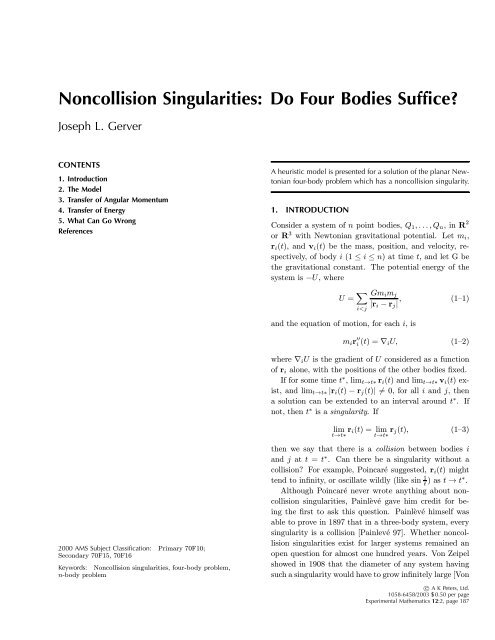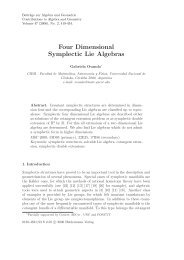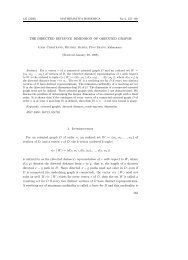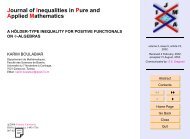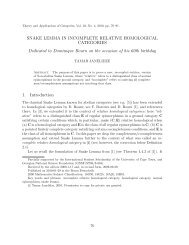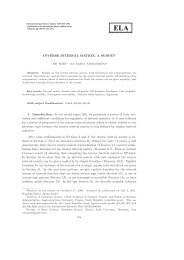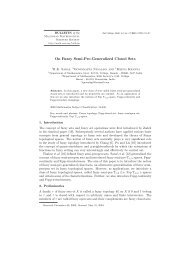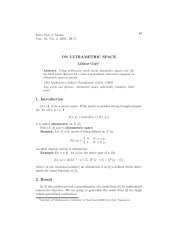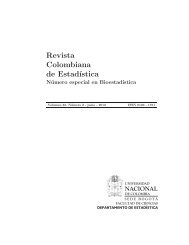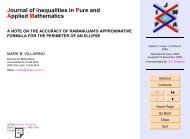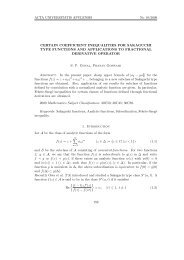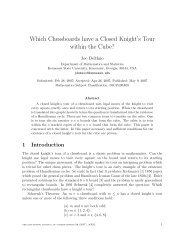Noncollision Singularities: Do Four Bodies Suffice?
Noncollision Singularities: Do Four Bodies Suffice?
Noncollision Singularities: Do Four Bodies Suffice?
You also want an ePaper? Increase the reach of your titles
YUMPU automatically turns print PDFs into web optimized ePapers that Google loves.
Gerver: <strong>Noncollision</strong> <strong>Singularities</strong>: <strong>Do</strong> <strong>Four</strong> <strong>Bodies</strong> <strong>Suffice</strong>? 189FIGURE 2.the order of µ) compared to the energy of Q 3 , but sincethe total energy is zero, Q 4 must have a positive energywhich nearly cancels the negative energy of Q 3 .Thus,Q 4approaches Q 2 along a hyperbolic orbit. The semimajoraxis of the hyperbola is negative, but it must have nearlythe same absolute value as the semimajor axis of the ellipse.Because the asymptotes of the hyperbola do notcross at a particularly small angle, Q 4 never gets muchcloser than Q 3 does to Q 2 .EvenwhenQ 3 and Q 4 are atcomparable distances from Q 2 , their mutual attraction isneglible, and they continue to adhere closely to their respectiveconic sections. Only when Q 3 and Q 4 approacheach other much more closely than Q 2 do their orbitschange significantly. Around the time of a near collisionbetween Q 3 and Q 4 , their paths can be approximated byhyperbolic orbits around their common center of gravity.But when we compute the new orbits of Q 3 and Q 4around Q 2 after their near collision, we can approximatethe near collision by an actual elastic collision betweenQ 3 and Q 4 .We model the encounter between Q 4 and the orbitingpair as follows: Q 2 remains fixed at the origin, while Q 3travels around it in an elliptical orbit. Q 4 approachesfrom the left along a hyperbolic orbit, with the incomingasymptote parallel to the x-axis. (We take Q 1 to lieon the x-axis at −∞.) We ignore the attractive forcebetween Q 3 and Q 4 . The positive energy of Q 4 exactlycancels the negative energy of Q 3 . An elastic collisionoccurs between Q 3 and Q 4 (Figure 2). The velocities ofthese bodies after the collision are uniquely determinedby the fact that the collision is elastic (i.e., momentumand kinetic energy are conserved), and by the fact thatQ 4 mustendupinahyperbolicorbitapproachinganasymptote parallel to the x-axis, moving in the negativex direction (Figure 3).FIGURE 3.Inourapproximatemodel,oncewearegiventheinitialorbit of Q 3 , we are free to choose any point on that orbitfor the elastic collision. That means we must be free tochoose a hyperbolic orbit for Q 4 which intersects the orbitof Q 3 at the chosen point of collision, and we must befree to choose a relative phase for Q 3 and Q 4 so that bothbodies arrive at the collision point at the same time. Thisfreedom is a reasonable feature of our model, because asmall change in the position of Q 4 at the time of its encounterwith Q 1 will cause a small change in its directionof motion afterwards, and in the limit as the x-coordinateof Q 1 goes to −∞, this small change in direction becomesa large change in the y-intercept of the incoming asymptoteof the orbit of Q 4 around Q 2 , without affecting thedirection of the asymptote, which remains parallel to thex-axis. Likewise, a small change in the position of Q 3in its orbit at the time of one close encounter with Q 4will result in a small change in the semimajor axis of thenew orbit of Q 3 after the encounter. This in turn affectsthe number of revolutions of Q 3 until its next encounterwith Q 4 , and thus results in a large change in the positionof Q 3 at the next encounter. So by fine-tuning theinitial conditions, it ought to be possible to adjust they-coordinate of the incoming asymptote of Q 4 and thephase of Q 3 at every future encounter between these twobodies.3. TRANSFER OF ANGULAR MOMENTUMReturning to our approximate model, we suppose thatinitially the orbit of Q 3 has eccentricity ε 0 ,where0
190 Experimental Mathematics, Vol. 12 (2003), No. 2so that Q 3 travels counterclockwise around Q 2 , that themajor axis of the orbit coincides with the y-axis, and theperiapsis lies on the negative y-axis. We also assume,without loss of generality, that the semimajor axis of theorbit is 1.Let ε 1 = 1 − ε 2 0 . Note that 2√ 1 2 < ε1 < 1sothatε 0 < ε 1 . We will show that for a suitable choice of thepoint of collision between Q 3 and Q 4 , the orbit of Q 3after the collision will have eccentricity ε 1 , with negative(clockwise) angular momentum. The major axis of thenew orbit will still coincide with the y-axis, with the periapsisat y 0), uniquelydetermine v x , v y , u x ,andu y ,viz.v x = −ε2 1ε 0 ε 1 +1 , (3—9)v y = −ε 0ε 0 ε 1 +1 , (3—10)u x =ε 2 0ε 0 ε 1 +1 , (3—11)andε 1u y =ε 0 ε 1 +1 . (3—12)We must find old and new hyperbolic orbits for Q 4 ,both with energy + 1 2, with the incoming asymptote ofthe old orbit and the outgoing asymptote of the new orbitboth parallel to the negative x-axis, such that both orbitsintersect the point (X, Y ) and the total momentum of Q 3and Q 4 is the same before and after the collision.Both hyperbolas will have semimajor axis −1, withone focus at the origin, and one asymptote y = −p forsome real number p (Figure 4). Suppose the asymptotesintersect at an angle of 2ψ. Letand˜x = x cos ψ + y sin ψ (3—13)ỹ = y cos ψ − x sin ψ +cscψ. (3—14)Then the equation of the hyperbola isand p =cotψ (Figure 5).ỹ 2 − (˜x tan ψ) 2 = 1 (3—15)
Gerver: <strong>Noncollision</strong> <strong>Singularities</strong>: <strong>Do</strong> <strong>Four</strong> <strong>Bodies</strong> <strong>Suffice</strong>? 191Each factor on the left-hand side of (3—21) representsone branch of the hyperbola. The first factor is thebranch closest to the focus at the origin, occupied byQ 2 . This branch is the projection onto the xy-plane ofthe intersection of the plane z = p 2 − yp − x with thehalf-cone z = r. The second factor is the branch closestto the empty focus, the projection of the intersection ofthe same plane with the half-cone z = −r. Q 4 followsthe first branch, so if the orbit of Q 4 is to intersect thepoint (X, Y ), we must havep 2 + Yp− X − R =0, (3—22)where R = √ X 2 + Y 2 .Thus,p = p 1 or p 2 ,whereFIGURE 5.Translating back to x and y coordinates, we have(y cos ψ − x sin ψ +cscψ) 2 − (x sin ψ + y sin ψ tan ψ) 2 =1,(3—16)ory 2 (cos 2 ψ − sin 2 ψ tan 2 ψ) − 2xy(sin ψ cos ψ+sin 2 ψ tan ψ)+2y cot ψ − 2x +csc 2 ψ =1. (3—17)A few trig identities yieldory 2 (1 − tan 2 ψ) − 2xy tan ψ +2y cot ψ (3—18)− 2x +1+cot 2 ψ =1,y 2 1 − 1 2xy −p 2 p +2yp − 2x + p2 =0. (3—19)Multiplying by p 2 and collecting like powers of p, wegetorp 4 +2yp 3 +(y 2 − 2x)p 2 − 2xyp − y 2 = 0 (3—20)(p 2 + yp − x − r)(p 2 + yp − x + r) =0, (3—21)where r = x 2 + y 2 .p 1 = −Y + Y 2 +4(X + R)(3—23)2andp 2 = −Y − Y 2 +4(X + R). (3—24)2We choose y = −p 1 to be the incoming asymptote ofthe old orbit of Q 4 , and y = −p 2 to be the outgoingasymptote of the new orbit.Let ˆv x and ˆv y be the x and y components of the velocityof Q 4 going into the collision, and let û x and û ybe the components of its velocity coming out. The angularmomentum of Q 4 is p 1 before the collision and −p 2afterwards, while its energy is 1 both before and after.2Thus,Xˆv y − Y ˆv x = p 1 , (3—25)1 2ˆv2 x +ˆv y2 − R −1 = 1 2 , (3—26)Xû y − Y û x = −p 2 , (3—27)and1 û2 2 x +û 2 y − R −1 = 1 2 . (3—28)These constraints determine ˆv x ,ˆv y ,û x ,andû y ,onceweknow the signs of Xˆv x + Y ˆv y and Xû x + Y û y .Thefactthat the incoming asymptote of the old orbit and theoutgoing asymptote of the new orbit are parallel to thex-axis constrains both signs to be positive. We concludethatandˆv x =1−Y ,Rp 1(3—29)ˆv y = 1 ,Rp 1(3—30)û x = −1+YRp 2, (3—31)û y = −1Rp 2. (3—32)
192 Experimental Mathematics, Vol. 12 (2003), No. 2Indeed,R = (ε 0 ε 1 ) 2 +(ε 0 + ε 1 ) 2 = ε 2 0 ε2 1 + ε2 0 +2ε 0ε 1 + ε 2 1= ε 2 0 ε2 1 +2ε 0ε 1 +1= ε 0 ε 1 +1=1− X, (3—33)whileandu y − v y = ε 0 + ε 1ε 0 ε 1 +1 = Y R(3—40)ˆv y − û y = 1Rp 1+ 1Rp 2= Y R . (3—41)so X + R =1,p 2 1 + Yp 1 − 1=0,p 1 =1/p 1 − Y ,andX 1 Y X + Y 2− Y 1 − = − YRp 1 Rp 1 Rp 1= −ε 0ε 1 +(ε 0 + ε 1 ) 2− YRp 1= ε2 0 + ε 0ε 1 + ε 2 1− YRp 1= 1+ε 0ε 1− Y = 1 − Y = p 1 .Rp 1 p 1(3—34)Likewise,Y 2 +1=ε 2 0 +2ε 0 ε 1 + ε 2 1 +1=2ε 0 ε 1 +2=2R, (3—35)so Y 2 1 2 2 2Y1 − + − =1− + Y 2 +1Rp 1 Rp 1 R Rp 1 R 2 p 2 − 21 R=1− 2Y +2RRp 1 R 2 p 2 − 21 R=1− 2Y + 2Rp 1 Rp 2 − 21 R=1− 2Rp 2 (p 2 1 + Yp 1 − 1)1=1, (3—36)and in a similar manner, we can show that the constraintsinvolving û x and û y are satisfied.We now need only show that momentum is conservedduring the collision between Q 3 and Q 4 . That is, wemust show that v x +ˆv x = u x +û x and v y +ˆv y = u y +û y .Indeed,u x − v x = ε2 0 + ε2 1ε 0 ε 1 +1 = 1 R , (3—37)and since1p 1+ 1 p 2= p 1 + p 2p 1 p 2=we haveˆv x − û x =2−−Y14 [Y 2 − (Y 2 +4)]= Y, (3—38)Y −Y =2− Y 2Rp 1 Rp 2 R = 2R − Y 2= 1 R R ,(3—39)4. TRANSFER OF ENERGYWe next examine the second collision, in which Q 4 extractsenergy from Q 3 , but no angular momentum is exchanged.This time, the orbit of Q 3 before the collisionhas eccentricity ε 1 and semimajor axis 1, and the orbitafterwards has eccentricity ε 0 and semimajor axis ε 2 0 /ε2 1 .Both orbits have negative angular momentum and majoraxes coinciding with the y-axis, but before the collision,the periapsis is on the negative y-axis, and afterwards, itis on the positive side (Figure 6). The equation of theold orbit isx 2ε 2 +(y − ε 1 ) 2 =1 (4—1)0and that of the new orbit isε 2 1ε 4 0x 2 + ε 2 1 2ε 2 y + ε 0 =1. (4—2)0Note that Q 3 has angular momentum −ε 0 both beforeand after the collision, but its energy decreases from − 1 2to −ε 2 1 /2ε2 0 .This time, the collision occurs at ( ˜X,Ỹ ), where˜X = ε 2 0 (4—3)FIGURE 6.
Gerver: <strong>Noncollision</strong> <strong>Singularities</strong>: <strong>Do</strong> <strong>Four</strong> <strong>Bodies</strong> <strong>Suffice</strong>? 193andThus√Ỹ =0. (4—4)2ˆv y =(4—18)ε 0Again we let v x and v y be the x and y components of thevelocity of Q 3 before the collision, and let u x and u y beandthe components of the velocity afterwards. We haveˆv x =1. (4—19)˜Xv y − Ỹv Note that the solution ˆv x = −1 is ruled out by the conditionthat the incoming asymptote of the orbit be parallelx = −ε 0 , (4—5)12 (v2 x + v2 y ) − ( ˜X 2 + Ỹ 2 ) −1/2 = − 1 2 , (4—6)to the x-axis.After the collision, the energy of Q 4 is −ε 2 1/2ε 2 0,sothe˜Xu y − Ỹu semimajor axis of the hyperbolic orbit of Qx = −ε 0 , (4—7)4 is −ε 2 0 /ε2 1andthespeedofQ 4 at infinity is ε 1 /ε 0 . We can normalizeandthe semimajor axis to −1 if we replace x and y by xε 2 1 /ε2 012 (u2 x + u 2 y) − ( ˜X 2 + Ỹ 2 ) −1/2 = − ε2 and yε 2 11/ε2 0 , respectively. If the outgoing asymptote is2ε 2 , (4—8) yε 2 1 /ε2 0 = −p, thenp must satisfy2while ˜Xv x + Ỹv y < 0and ˜Xu x + Ỹu y > 0. These constraintsuniquely determine the velocity of Q 3 before andp 2 + Ỹpε2 1/ε 2 0 − ˜Xε 2 1/ε 2 0 − ˜Rε 2 1/ε 2 0 =0, (4—20)where againafter the collision:Ỹ =0and ˜X = ˜R = ε 2 0.Thus,p = ± √ 2ε 1 .v x = − ε 1This time, we choose p = − √ 2ε 1 , so the outgoing asymptoteis yε 2 1 /ε2 0 = √ 2ε 1 ,ory = √ 2ε 2 0 /ε 1, and the an-, (4—9)ε 0v y = − 1 gular momentum of Q 4 is still ( √ 2ε 2 0, (4—10)/ε 1)(ε 1 /ε 0 )= √ 2ε 0 .ε 0Therefore, if û x and û y are the components of the velocityof Qu x =1, (4—11)4 immediately after the collision, we haveandu y = − 1 ε 2 0û y = √ 2ε 0 (4—21). (4—12)ε 0 andThe orbit of Q 4 before and after the collision is easilydetermined. Beforehand, we can still approximate12 (û2 x +û2 y ) − 1 ε 2 = ε2 10 2ε 2 . (4—22)0the energy of Q 4 as 1 2 , because Q 4 transfers a negligible Thus,√amount of energy (on the order of µ) toQ 1 between its2û y =(4—23)two encounters with Q 3 . Thus, the incoming asymptoteε 0of Q 4 should be y = −p, wherep satisfiesandp 2 + Ỹp− ˜X − ˜R û x = − ε 1. (4—24)=0, (4—13)ε 0with ˜R= ˜X2 + Ỹ 2 = ε 2 0 . Hence, p = ±√ (The outgoing asymptote of the new orbit of Q 4 is parallelto the x-axis, so û x must be negative.)2ε 0 . We letp = √ 2ε 0 , so that the incoming asymptote is y = − √ 2ε 0 ,Because the total energy of Q 3 and Q 4 is zero both beforeand after the collision, we need only show that mo-and the angular momentum of Q 4 before the collisionis √ 2ε 0 . Letting ˆv x and ˆv y be the components of thementum is conserved to prove that the collision is elastic.velocity of Q 4 going into the collision, we haveWe have˜Xˆv y − Ỹ ˆv x = p (4—14)u x − v x =1+ ε 1=ˆv x − û x (4—25)ε 0andand12 (ˆv2 x +ˆv y) 2 − ˜R −1 = 1 2 , (4—15)u y − v y =0=ˆv y − û y . (4—26)orε 2 0ˆv y = √ After the second encounter of Q 4 with Q 3 , the orbit2ε 0 (4—16)of Q 3 has the same eccentricity ε 0 that it had before thefirst encounter, but the orbit is smaller by a factor ofand12 (ˆv2 x +ˆv2 y ) − ε−2 0 = 1 ε 2 1/ε 22 . (4—17) 0 and has been reflected around the x axis. We cantherefore arrange for Q 4 to have another encounter with
194 Experimental Mathematics, Vol. 12 (2003), No. 2Q 3 after a roundtrip to Q 1 , in which the phase of Q 3 isthesameasatthefirst encounter (but reflected aboutthe x axis), so that Q 4 again extracts angular momentum,but no energy, from Q 3 , and this can be followed bya fourth encounter in which Q 4 extracts energy from Q 3 ,but no angular momentum. After this fourth encounter,the orbit of Q 3 is once again reflected about the x-axis,back to the same side where it started, but smaller byafactorofε 4 1 /ε4 0 . The process can be continued indefinitely,with the orbit of Q 3 shrinking by the same factorof ε 2 1 /ε2 0 at every second encounter with Q 4. The energyof Q 4 increases by a factor of ε 2 1 /ε2 0 at each suchencounter, and it only loses O(µ) when it swings aroundQ 1 , so its velocity during the trip between Q 1 and Q 2(exceptwhenitisclosetoQ 1 or Q 2 , and its potentialenergy is comparable to its kinetic energy) increases by afactor of nearly ε 1 /ε 0 , which is greater than 1. Becausethe distance between Q 1 and Q 2 increases only slightly,by a factor of 1 + O(µ), during each roundtrip of Q 4 ,the time required for each double roundtrip decreases ingeometric progression, by a factor only slightly greaterthan ε 0 /ε 1 ; this factor is strictly less than 1, providedwe choose ε 0 not too close to 2√ 1 2. That means an infinitenumber of roundtrips occur in a finite time. Duringeach roundtrip, a small fraction of the energy of Q 4 istransferred to the outward motion of Q 1 and Q 2 awayfrom each other (with Q 3 dragged along by Q 2 ), so afteran infinite number of roundtrips, Q 1 and Q 2 will havemovedaninfinite distance apart along the x-axis. Thus,a noncollision singularity occurs after a finite time.5. WHAT CAN GO WRONGSeveral things could go wrong with this scenario, and wemust check that none of them happen.Before an angular momentum extracting encounterbetween Q 3 and Q 4 , the former travels along an ellipseand the latter along a hyperbola. The encounter occurswhen the two bodies pass close to the point of intersectionof the ellipse and hyperbola at the same time. Butthe ellipse and hyperbola intersect at two points, andboth bodies pass the wrong point before approaching thecorrect one (Figure 7). We must check that if the relativephases of Q 3 and Q 4 are such that they approachthe right point of intersection at the same time, thenthey do not also approach the wrong point at the sametime. In other words, we need to prove that Q 3 andQ 4 donotbothrequirethesametimetomovebetweenthe two points of intersection. It is straightforward toFIGURE 7.demostrate this numerically for any given ε 0 . For example,when ε 0 = 1 , the right point of intersection is2(X, Y ) = (− 4√ 1 3,12 + √ 12 3) = (−.433, 1.366) and thewrong point is (−.480, −.332). Q 3 requires 4.226 units oftime to move from the wrong point to the right point, andQ 4 requires only .995 units of time. It seems to be truein general that Q 3 requires more time than Q 4 , althoughit is not clear how to prove this for arbitrary ε 0 .After an angular momentum extracting encounter betweenQ 3 and Q 4 , the new orbits of the two bodies donot cross again. Likewise, the orbits do not cross beforean energy extracting encounter, because ˆv y /ˆv x >v y /v x(Figure 8). The orbits do cross after an energy extractingencounter, provided ε 0 < 3√ 1 3(thatis,whenû y /û x >u y /u x ), but once again, Q 3 takes much longerthan Q 4 to traverse its arc (Figure 9). So in both cases,the two bodies do not interfere with each other beforeFIGURE 8.
Gerver: <strong>Noncollision</strong> <strong>Singularities</strong>: <strong>Do</strong> <strong>Four</strong> <strong>Bodies</strong> <strong>Suffice</strong>? 195andu y − u y +û y2= − v y − v y +ˆv y2(5—2)or, equivalently, v x + u x =ˆv x +û x and v y + u y =ˆv y +û y .At the angular momentum extracting encounter, we havev x + u x = ε2 0 − ε2 1ε 0 ε 1 +1 = −Y R (ε 1 − ε 0 ), (5—3)FIGURE 9.their encounter, and they make a clean getaway afterwards.Next, we must check that none of the bodies have anactual binary collision before the noncollision singularity.Any such collision would have to involve Q 4 , because Q 1never gets close to Q 2 or Q 3 , and these last two cannotcollide with each other because Q 3 is always in anelliptical orbit around Q 2 with eccentricity ε 0 or ε 1 .It is easy to check that Q 4 never collides with Q 2 .Weneed only check the four hyperbolic orbits of Q 4 aroundQ 2 , namely before and after an angular momentum extractingencounter with Q 3 , and before and after an energyextracting encounter. Specifically, we must calculatethe asymptote parallel to the x-axis for each of the fourhyperbolas. These are, respectively, y = 1 2 (Y −√ Y 2 +4),where Y = ε 0 + ε 1 , y = 1 2 (Y + √ Y 2 +4), y = − √ 2ε 0 ,and y = √ 2ε 2 0/ε 1 . In no case is the asymptote y =0,sothere is no collision with Q 2 .To see that Q 4 does not collide with Q 3 ,wemustlookat the velocities of both bodies going into and comingout of both the angular momentum and energy extractingencounters. Although we approximated each suchencounter by an elastic collision, Q 3 and Q 4 actuallytravel in close hyperbolic orbits around their center ofgravity during these encounters. A true binary collisionbetween these bodies can occur only if the hyperbolas aredegenerate. That is, the velocity of each body after theencounter, in the center of mass coordinate system of thetwo bodies, must be in the direction opposite the velocityof that body before the encounter. In other words, itwould require thatu x − u x +û x2= − v x − v x +ˆv x 2(5—1)ˆv x +û x =andv y + u y = ε 1 − ε 0ε 0 ε 1 +1 = 1 R (ε 1 − ε 0 ), (5—4)YRp 2−YRp 1= Y Rp 1 − p 2 −Y =p 1 p 2 RY2+4,(5—5)ˆv y +û y = 1 − 1 = 1 Y2+4. (5—6)Rp 1 Rp 2 RThus, a collision can occur only if ε 1 − ε 0 = √ Y 2 +4=√ 2ε0 ε 1 + 5. Squaring both sides, we see that this implies1 − 2ε 0 ε 1 = 2ε 0 ε 1 +5, or ε 0 ε 1 +1 = R = 0, so nocollision occurs during the angular momentum extractingencounter. At the energy extracting encounter, we findthat indeedbutv x + u x =1− ε 1ε 0=ˆv x +û x , (5—7)v y + u y = − 2 ε 0(5—8)andˆv y +û y = 2√ 2, (5—9)ε 0so again there is no collision between Q 3 and Q 4 .The one remaining possibility is a collision betweenQ 4 and Q 1 . Each time Q 4 passes close to Q 1 ,itgetssent back toward Q 2 and Q 3 .Thus,thevelocityofQ 4 isrotated by very nearly 180 degrees during its encounterwith Q 1 , and the two bodies come close to a binary collision.We must show that the rotation is never exactly180 degrees in the center of mass coordinate system ofthe two bodies.We firstlookatthepathofQ 4 in a Q 2 -centered system.We must consider two cases: In the first case, Q 4encounters Q 1 after extracting angular momentum fromQ 3 and before extracting energy. In the second case,Q 4 encounters Q 1 after extracting energy from Q 3 andbefore extracting angular momentum. After extractingangular momentum, Q 4 moves toward the left along apath asymptotic to the line y = 1 2 (ε 0 + ε 1 + √ 2ε 0 ε 1 +5).When it heads back toward Q 2 to extract energy, Q 4
196 Experimental Mathematics, Vol. 12 (2003), No. 2FIGURE 10.movesalongapathasymptotictotheliney = − √ 2ε 0 .Of course, the two lines cannot really be parallel. Theymust converge slightly and intersect near Q 1 (Figure 10).Because Q 4 has different y-coordinates right after extractingangular momentum and right before extractingenergy, its velocity coming out of its encounter with Q 1cannot be exactly in the opposite direction from its velocitygoing into the encounter. Likewise, right after extractingenergy from Q 3 , Q 4 is on a path asymptoticto y = √ 2ε 1 ,ifwenormalizethex and y coordinatesso that the semimajor axis of the orbit of Q 3 is 1 (Figure11). Right before the following angular momentumextracting encounter, the path of Q 4 is asymptotic toy = 1 2 (−ε 0 − ε 1 + √ 2ε 0 ε 1 +5)< √ 2ε 1 . (Recall that thisangular momentum extracting encounter, after normalization,is the reflection about the x-axis of the previousangular momentum extracting encounter.) Again, the y-coordinates are different, so the direction of Q 4 is notexactly reversed during its encounter with Q 1 .However, we have been considering the velocity of Q 4relative to Q 2 . What counts is the velocity of Q 4 relativeto Q 1 . If Q 1 should have a small y-component to itsvelocity, on the order of the y-component of the velocityof Q 4 , then it could still happen that the velocity of Q 4relative to Q 1 does exactly reverse its direction duringthe encounter between Q 4 and Q 1 , in which case theencounter would be a binary collision.We can rule out this possibility because the total angularmomentum of the system is zero. Recall that Q 3 andQ 4 have mass 1, while Q 1 and Q 2 have mass µ −1 >> 1.We normalize the time and distance scales so that thesemimajor axis of the orbit of Q 3 is 1, and the mean velocityof Q 3 in its orbit is 1. Then the energy of Q 3 isapproximately − 1 2 . Since the kinetic energy of Q 1 andQ 2 are much less than 1 (on the order of µ), and theFIGURE 11.total energy of the system is zero, the energy of Q 4 isapproximately 1 2 ,andthevelocityofQ 4 (except when itis close to Q 1 or Q 2 ) is approximately 1. The energy ofQ 1 and Q 2 remains on the order of µ times the energy ofQ 4 , because each time Q 4 encounters Q 1 or the orbitingpair, it transfers to them approximately 2 units momentum.Therefore, the velocity of Q 1 and the orbiting pairaway from each other both increase by about 2µ timesthe velocity of Q 4 at each encounter. But since the velocityof Q 4 increases by a factor of ε 1 /ε 0 > 1ateverysecond encounter with the orbiting pair, the velocity ofQ 1 and the orbiting pair away from each other is of thesame order as the change in this velocity. That is, thevelocity of Q 1 and the orbiting pair is on the order of µtimes the velocity of Q 4 , and the kinetic energy of Q 1and the orbiting pair is on the order of µ −1 µ 2 = µ timesthe energy of Q 4 .Let χ be the distance between Q 1 and Q 2 (in units ofthe semimajor axis of the orbit of Q 3 ). Now the angularmomentum of Q 2 and Q 3 about their center of mass ison the order of 1 (it goes from ε 1 to −ε 0 to −ε 1 to ε 0 andback to ε 1 in our normalized units). Likewise, when Q 4is midway between Q 1 and Q 2 , the angular momentumof Q 4 about the center of mass of all four bodies is on theorder of 1 (it is ± 1 4 (ε 0 + ε 1 ) ± 1 4√ 2ε0 ε 1 +5or± √ 2ε 0 innormalized units). That means the angular momentumof Q 1 and the orbiting pair about the center of mass ofall four bodies must be on the order of 1, so that the totalangular momentum of the system is zero. Since Q 1 andthe orbiting pair are both about 1 2χ distance units, inthenegativeandpositivex directions, respectively, fromtheir center of mass, both must have momentum with ay-component on the order of χ −1 ,andvelocitywithay-component on the order of µχ −1 .They-component ofthe velocity of Q 4 , however, must be on the order of χ −1 ,because in the time it takes Q 4 to make a roundtrip fromQ 2 to Q 1 and back, namely 2χ, they-coordinate of theposition of Q 4 must change by something on the order of1 (indeed, by either √ 2ε 0 + 1 2 (ε 0 + ε 1 + √ √2ε 0 ε 1 +5) or2ε1 + 1 2 (ε 0+ε 1 − √ 2ε 0 ε 1 + 5) times the semimajor axis).Since µχ −1
Gerver: <strong>Noncollision</strong> <strong>Singularities</strong>: <strong>Do</strong> <strong>Four</strong> <strong>Bodies</strong> <strong>Suffice</strong>? 197χ −1 , close to but certainly not equal to zero, and thereis no collision between Q 4 and Q 1 .Next, we must check that by varying the phase of Q 3at its encounter with Q 4 , we can vary the amount of energytransferred to Q 4 . Increasing the energy transferredhas the effect of increasing the velocity of Q 4 ,andalsoincreasing, by the same factor, the mean velocity of Q 3over its entire orbit. But the orbit shrinks, so that Q 3makes more revolutions in the time that Q 4 travels to Q 1and back. A small change, on the order of χ −1 ,inthephase of Q 3 at one encounter, would therefore result in alarge change, on the order of 1, in the phase of Q 3 at itsnext encounter with Q 4 . It is this mechanism that enablesus to simultaneously select the approximate phaseof Q 3 at an infinite number of future encounters.As we did earlier, we let µ tendtozerosothatwecan model the encounters as elastic collisions betweenQ 3 and Q 4 , and we assume that the incoming asymptoteof the orbit of Q 4 before the encounter, and the outgoingasymptote after the encounter are in the negative x direction.But we do not assume that the encounter occursat (X, Y ), where X and Y are functions of the initial eccentricityε 0 as defined in (3—1) and (3—2). Instead, weallow Q 3 to be anywhere in its orbit at the time of theencounter. That means ε 1 , the eccentricity of the orbitafter the encounter, is not necessarily equal to 1 − ε 2 0 ,and the length and direction of the major axis of the orbitare not necessarily unchanged by the encounter. Rather,all three orbital parameters are functions of the phaseof Q 3 in its orbit at the time of the encounter (and alsofunctions of ε 0 ).Let φ 0 be the phase of Q 3 at an angular momentumextracting encounter with Q 4 ,letφ 1 be the phase of Q 3at the following energy extracting encounter, let s 1 bethe semimajor axis of the orbit of Q 3 between the twoencounters, and let s 2 be the semimajor axis after thesecond encounter. We take s 0 , the semimajor axis beforethe firstencounter,tobe1. Ifweholdε 0 fixed at12 and vary φ 0, then numerical calculations reveal thatds 1 /dφ 0 = −1.85 when φ 0 = π − arctan(2 + 2 3√3), thisbeing the phase of Q 3 at (X, Y ). If, on the other hand,we hold ε 1 fixed at 1 2√3ands1 fixedat1whilewevaryφ 1 ,thends 2 /dφ 1 = .38 when φ 1 = 0. Since neither derivativeis zero, we can indeed control the phase of Q 3 ateach encounter, at least when ε 0 = 1 2 .Finally, we need a method for making small adjustmentsto the eccentricity and angle of periapsis of theorbit of Q 3 . In our approximate model for the encountersbetween Q 3 and Q 4 , we assumed an elastic collisionbetween these bodies, rather than a close approach alonghyperbolic orbits. We also neglected the small gravitationalattraction between Q 3 and Q 4 when they are notclose to each other, and we neglected the gravitationalfield of Q 1 . Finally, we assumed that the encounter betweenQ 3 and Q 4 occurred at precisely the correct phaseof Q 3 , but in fact this phase can only be controlled approximatelyat each encounter, because small changesmust be made in the phase in order to control the phaseat the next encounter. As a result of all these factors, theeccentricity of the orbit of Q 3 will not precisely alternatebetween ε 0 and ε 1 , and the major axis of the orbit willnot always be exactly perpendicular to the line throughQ 1 and Q 2 . Indeed, after a large number of encounters,the orbit might drift so far from its ideal parameters thatwe cannot continue.To avoid this possibility, we must show that wheneverthe eccentricity and angle of periapsis drift too far, theycan be nudged back by slightly changing the phase ofQ 3 at the time of its encounter with Q 4 . Once again,we fix the eccentricity at ε 0 = 1 2 ,andtheangleofperiapsisat θ 0 = − π (that is, the major axis of the ellipse2is perpendicular to the line through Q 1 and Q 2 , whileQ 3 , which has positive angular momentum, is movingtoward periapsis when it crosses the line between Q 1 andQ 2 ) shortly before an angular momentum extracting encounter.As usual, we approximate the encounter by anelastic collision. By varying the phase φ 0 of Q 3 at thetimeoftheencounter,wevarybothε 1 and θ 1 , the eccentricityand angle of periapsis of the orbit, respectively,after the encounter. The orbit doesn’t change again untilthe following energy extracting encounter. Supposewe independently vary the phase φ 1 of Q 3 at the timeof the energy extracting encounter, and we let ε 2 and θ 2be the eccentricity and angle of periapsis, respectively, ofthe orbit of Q 3 afterwards. Then we can think of ε 2 andθ 2 as functions of two variables φ 0 and φ 1 . (Note that ε 1is equal to 1 − ε 2 0 if φ 0 = π −arctan[ε −10 +(1−ε2 0 )−1/2 ],in which case ε 2 = ε 0 if φ 1 = 0, but in general ε 1 and ε 2have other values.) Numerical calculations reveal thatand∂ε 2∂φ 0=1.81, (5—10)∂θ 2∂φ 0= −2.92, (5—11)∂ε 2∂φ 1= −.16, (5—12)∂θ 2∂φ 1=0, (5—13)
198 Experimental Mathematics, Vol. 12 (2003), No. 2when φ 0 = π − arctan(2 + 3√ 2 3) and φ1 =0. Sincethematrix 1.81 −2.92(5—14)−.16 0.is nonsingular, we can always bring ε and θ back into lineby making small adjustments to φ at two successive encountersof Q 3 and Q 4 . For example, suppose we want toensure that ε is always within δ of 1 2 or 2√ 1 3(dependingon whether the last encounter extracted energy or angularmomentum) and θ is always within δ of π 2 .Forfixedδ, wecanchooseµ small enough that ε and θ stay withinthese intervals for an arbitarily large number of encounters.When they come close to drifting out of their intervals,we can recenter them by making adjustments toφ at two successive encounters. These adjustments willbe on the order of δ, so they will not interfere with ourability to control future values of φ, forwhichweneedtomake much smaller adjustments, on the order of χ −1 .We remark that s, the semimajor axis of the orbit ofQ 3 , will also tend to drift away from its nominal valueof ε 2n0 /(1 − ε 2 0) n after 2n encounters. But there is noneed to adjust s. Because the total energy of the systemis zero, the energies of all bodies remain in proportion.As long as s shrinks in geometric progression with everyenergy extracting encounter (that is, as long as s 2n+2 /s 2nis bounded from above for all n by a constant strictlylessthan 1), there will be an infinite number of encountersin a finite time, and hence a noncollision singularity.REFERENCES[Gerver 91] J. L. Gerver. “The Existence of Pseudocollisionsin the Plane.” J. Differential Equations 89 (1991), 1—68.[Mather and McGhee 75] J. Mather and R. McGehee. “Solutionsof the Collinear <strong>Four</strong> Body Problem which BecomeUnboundedinFiniteTime.”InLecture Notes in Physics38, edited by J. Moser, pp. 575—597. Berlin-New York:Springer-Verlag, 1975.[McGehee 84] R. McGehee. “A Note on a Theorem of VonZeipel.” Report No. 19 (1984), Institut Mittag-Leffler.[Painlevé 97] P. Painlevé. Lecons sur la Théorie Analytiquedes Équations Différentielles. Paris: Hermann, 1897.[Saari 72] D. G. Saari. “<strong>Singularities</strong> and Collisions of NewtonianGravitational Systems.” Arch. Rational Mech.Anal. 49 (1972), 311—320.[Saari 77] D. G. Saari. “A Global Existence Theorem for the<strong>Four</strong> Body Problem of Newtonian Mechanics.” J. DifferentialEquations 26 (1977), 80—111.[Von Zeipel 08] H. Von Zeipel. “Sur les singularités duproblème des n corps.” Ark. Mat. Astro. Fys. 4:32(1908), 1—4.[Xia 92] Z. Xia. “The Existence of <strong>Noncollision</strong> <strong>Singularities</strong>in Newtonian Systems.” Ann. of Math. 135:2 (1992),411—468.Joseph L. Gerver, Department of Mathematics, Rutgers University, Camden, NJ 08102 (gerver@camden.rutgers.edu)Received March 25, 2003; accepted May 6, 2003.


